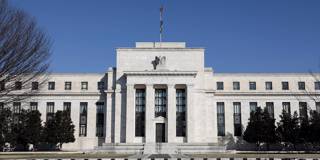The US Federal Reserve is a monument to the idea that the market, if left on its own, will destroy everything in its path, including itself. Three recent books suggest that the Fed has the capacity to function as a device of indicative planning, coordinating economic activities to fulfill democratically determined social purposes.
NEW YORK – By now you’ve probably heard of collateralized debt obligations, quantitative easing, helicopter drops, shadow banking, hedge funds, private equity, leveraged buyouts, asset pricing, cryptocurrencies, and so on. You may not be able to explain them all – to be honest, few can – but you know that they are somehow associated with central banking or high finance. Maybe you’ve also figured out the difference between fiscal and monetary policy, discretionary and otherwise. Quite possibly you can name the people who propose and enact such policy, like the current Federal Reserve chair, Jerome Powell, and his immediate predecessors, Janet Yellen, Ben Bernanke, and Alan Greenspan.
How come? Why are the arcane terms of finance – the “secrets of the temple,” as William Greider famously called them – so familiar, and how have its gray protagonists become household names?
The short answer is easy: where bankers go, it seems, shit inevitably meets fan. But even in the absence of scandal and/or a crisis on the scale of the post-2008 Great Recession, most economists, analysts, and business leaders agree that “financialization” of the economy is the reason that banking and bankers have obtruded so consequentially on everyday discourse in the United States. This is how Thomas Piketty’s Capital in the Twenty-First Century, a ponderous, utterly serious parody of Karl Marx’s Capital, could become a bestseller here as elsewhere in the world. And it is why the first signs of rebellion against this new regime appeared way downtown in Manhattan, where Wall Street could be occupied.

Edward Chancellor, The Price of Time: The Real Story of Interest, Atlantic Monthly Press, 2022.
Lev Menand, The Fed Unbound: Central Banking in a Time of Crisis, Columbia Global Reports, 2022.
NEW YORK – By now you’ve probably heard of collateralized debt obligations, quantitative easing, helicopter drops, shadow banking, hedge funds, private equity, leveraged buyouts, asset pricing, cryptocurrencies, and so on. You may not be able to explain them all – to be honest, few can – but you know that they are somehow associated with central banking or high finance. Maybe you’ve also figured out the difference between fiscal and monetary policy, discretionary and otherwise. Quite possibly you can name the people who propose and enact such policy, like the current Federal Reserve chair, Jerome Powell, and his immediate predecessors, Janet Yellen, Ben Bernanke, and Alan Greenspan.
How come? Why are the arcane terms of finance – the “secrets of the temple,” as William Greider famously called them – so familiar, and how have its gray protagonists become household names?
The short answer is easy: where bankers go, it seems, shit inevitably meets fan. But even in the absence of scandal and/or a crisis on the scale of the post-2008 Great Recession, most economists, analysts, and business leaders agree that “financialization” of the economy is the reason that banking and bankers have obtruded so consequentially on everyday discourse in the United States. This is how Thomas Piketty’s Capital in the Twenty-First Century, a ponderous, utterly serious parody of Karl Marx’s Capital, could become a bestseller here as elsewhere in the world. And it is why the first signs of rebellion against this new regime appeared way downtown in Manhattan, where Wall Street could be occupied.